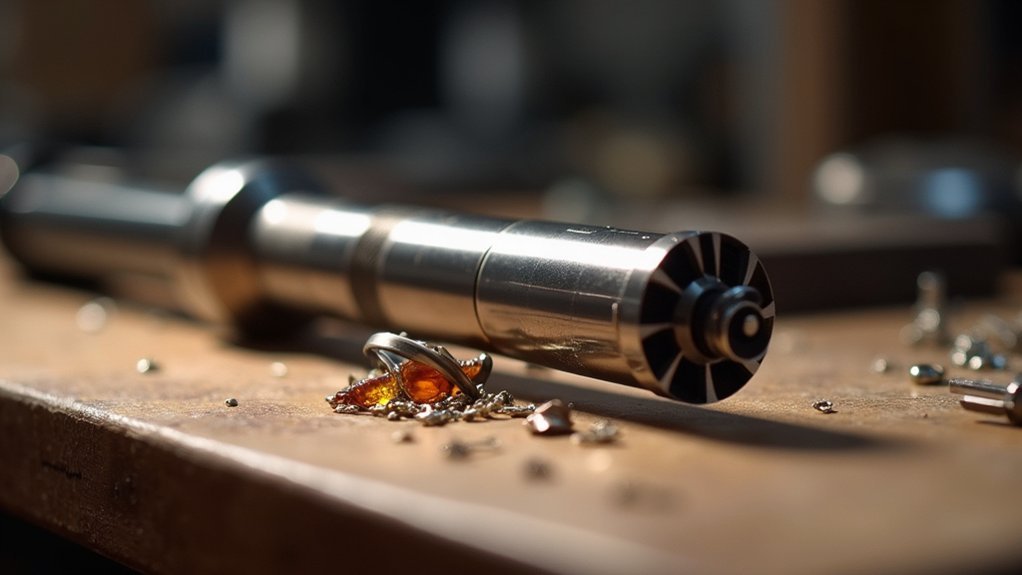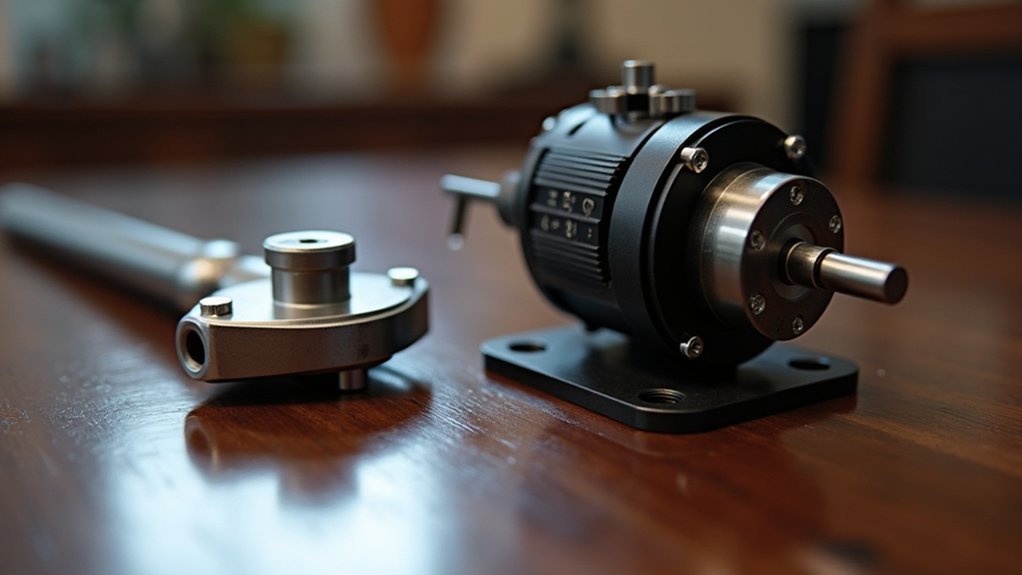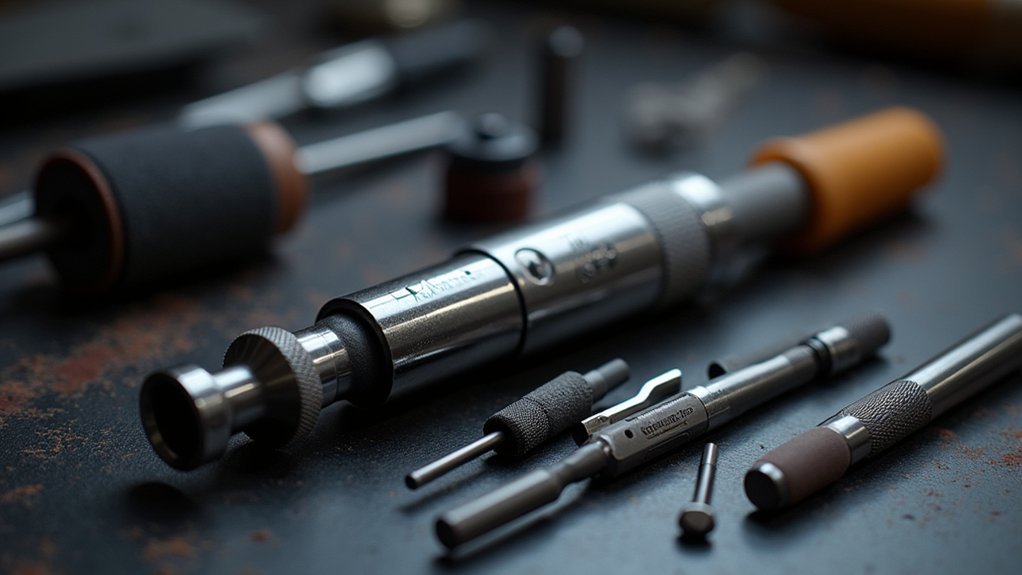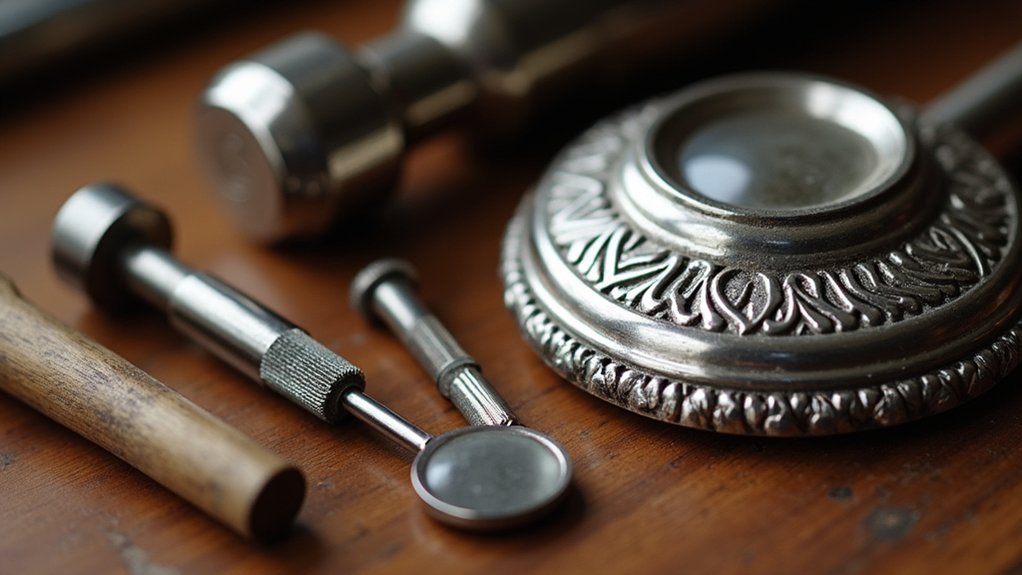You’ll master flex shaft jewelry-making by selecting the right gauge (20-12) for your materials, using thinner diameters for detailed work in tight spaces. Control speed based on material—low for soft metals like gold and silver, higher for titanium. Maintain a secure grip while wearing safety goggles and gloves, keeping the workspace clear. Clean after each use with mild soapy water and apply silicone spray lubricant regularly. These foundational techniques reveal advanced precision methods.
Understanding Flex Shaft Tool Components and Anatomy

Precision drives every successful golf club fitting, and understanding your flex shaft tool’s components forms the foundation of accurate measurements.
Your flex shaft tool consists of three essential parts: the shaft itself, a comfortable handle for grip control, and a measuring mechanism that calculates shaft deflection when weight’s applied to the tip.
Learning shaft anatomy helps you identify critical performance zones.
You’ll work with the tip section, midsection, and butt, each affecting how your club performs. The kick point determines where bending occurs during your swing, directly influencing ball trajectory and launch angle.
Don’t overlook torque—it measures your shaft’s resistance to twisting, impacting shot accuracy and feel.
Mastering these components guarantees you’ll make informed fitting decisions.
Selecting the Right Flex Shaft Size for Your Jewelry Project
Now that you’ve grasped the fundamental components of flex shaft tools, you’ll need to match the right shaft size to your specific jewelry project requirements.
Consider your material weight first—lighter pieces work better with more flexible shafts that provide superior handling and control. Measure your wire or bead gauge carefully, as compatibility ranges from 20 to 12 gauge and directly impacts project strength.
Material weight determines shaft flexibility needs—lighter pieces require more flexible shafts for optimal handling and precision control.
For intricate designs requiring precision, choose a thinner diameter like 1/8-inch or 1/16-inch, which allows detailed work in tight spaces.
Select a flex shaft with adjustable speed settings since different techniques demand varying RPMs for best results. Pay attention to torque and grip comfort—a proper grip prevents hand fatigue during extended sessions, enabling more detailed jewelry work.
Proper Safety Techniques When Operating Flex Shaft Tools

Three critical safety measures form the foundation of safe flex shaft operation in jewelry making.
First, you’ll need proper personal protective equipment, specifically safety goggles and gloves to shield against flying debris and potential injuries.
Second, maintain a secure grip on your tool while keeping hands and loose clothing away from the rotating shaft to prevent dangerous entanglement.
Before starting any project, verify that all safety guards are positioned correctly and functioning properly. This reduces your exposure to moving parts during operation.
Always clear your workspace of obstacles to prevent tripping hazards.
Most importantly, read the manufacturer instructions thoroughly before using any flex shaft tool. Each model has specific safety guidelines you must follow for safe operation.
Essential Attachments and Bits for Maximum Versatility
You’ll need the right attachments to match different shaft flex categories with your specific swing characteristics and playing style.
Understanding how torque affects your control becomes essential when selecting bits that complement your natural swing speed and tempo.
Speed matching guidelines will help you choose attachments that optimize your flex shaft’s performance across various shot situations.
Shaft Flex Categories
Understanding shaft flex categories forms the foundation of optimizing your golf performance, as each classification directly impacts how energy transfers from your swing to the ball.
You’ll encounter five main shaft flex categories: Ladies (L), Senior flex (A), Regular flex (R), Stiff flex (S), and Extra Stiff (X).
Your swing speed determines which category you’ll need. If you’re swinging under 75 mph, you’ll benefit from Ladies or Senior flex shafts. Regular flex works best for speeds between 75-95 mph, while Stiff flex suits 95-110 mph swings. Players exceeding 110 mph should consider Extra Stiff options.
Choosing incorrectly creates performance issues like excessive side spin and poor launch angles, making proper flex selection essential for consistent results.
Torque and Control
While shaft flex determines how much your club bends during the swing, torque controls how much the shaft resists twisting when you make contact with the ball.
Lower torque ratings give you better control and precision, making them ideal if you’re seeking accuracy in your shots. However, higher torque can provide a softer feel and higher ball trajectory, which benefits golfers with slower swing speeds who need extra loft.
Understanding the relationship between torque and shaft flex is vital for your game. High-torque shafts can worsen slicing or hooking problems due to increased head misalignment at impact.
If you’ve got faster swing speeds, you’ll benefit from lower torque shafts for improved consistency and accuracy in your shots.
Speed Matching Guidelines
When selecting the right shaft flex, matching your swing speed becomes the foundation for peak performance on the course.
You’ll need to understand specific speed ranges to choose correctly. Ladies or Senior flex works best for speeds under 75 mph, while Regular flex suits 75-95 mph swings. If you’re swinging 95-110 mph, a stiff shaft provides perfect control and accuracy.
Here are the essential speed matching guidelines:
- Measure your actual swing speed before selecting any flex
- Use the Project X shafts recommendations as your baseline reference
- Consider that faster swings require stiffer flexes for better control
- Remember that even 5-gram weight differences affect performance greatly
- Practice trial and error with different combinations to find your ideal setup
Testing various shaft flex options guarantees you’ll discover what works best for your unique swing characteristics.
Speed Control Methods for Different Jewelry Materials
Since different jewelry materials respond uniquely to various speeds, you’ll need to master specific control techniques for each type you work with. Soft metals like gold and silver require lower speeds to prevent damage, while hard materials such as titanium need higher speeds for effective shaping. The thickness of your material also matters—thicker pieces demand slower speeds for precision.
| Material Type | Recommended Speed | Special Considerations |
|---|---|---|
| Gold/Silver | Low | Prevent warping |
| Titanium | High | Requires force |
| Opals | Very Low | Heat sensitive |
| Sapphires | Medium-High | Durable stone |
| Thick Materials | Low | Avoid bending |
A variable speed tool gives you flexibility to start slowly for intricate details, then increase speed for polishing or larger cuts.
Handheld Vs Bench-Mounted Flex Shaft Setup Options

When you’re starting out, you’ll need to choose between handheld and bench-mounted flex shaft setups, each offering distinct advantages for different working styles.
Handheld units give you maximum portability and intuitive control, while bench-mounted systems provide superior stability and precision for detailed work.
Your budget will also play a key role in this decision, as the cost difference between these options can greatly impact your initial investment.
Handheld Setup Benefits
While bench-mounted flex shaft setups provide stability, handheld configurations offer distinct advantages that make them particularly valuable for beginners developing their swing mechanics.
Your handheld setup delivers exceptional flexibility and mobility, allowing you to practice from various angles and positions without location restrictions.
You’ll experience real-time feedback that enables immediate technique corrections during your swing development process.
Key benefits of handheld configurations include:
- Enhanced portability – lightweight design for easy transportation between practice locations
- Dynamic movement replication – better mimics actual swing feel compared to static bench setups
- Versatile practice environments – use at home, driving ranges, or multiple settings
- Immediate adjustability – make on-the-fly corrections without stopping your practice session
- Unrestricted positioning – work on different swing planes and angles naturally
This mobility transforms your practice sessions into more effective skill-building experiences.
Bench-Mounted Stability Advantages
As a beginner, you’ll find bench-mounted setups particularly valuable for developing your skills.
The enhanced stability helps you better understand shaft characteristics without wrestling with equipment handling complications. You’ll also benefit from improved safety, as the shaft remains securely positioned throughout testing.
Many bench-mounted systems include built-in measuring devices that provide more accurate readings than handheld methods, making your learning process smoother and more reliable.
Cost Comparison Analysis
Understanding these stability benefits naturally leads to budget considerations when choosing your first flex shaft setup.
Handheld models offer excellent affordability at $50-$150, perfect for beginners wanting portable practice options. Bench-mounted setups require a larger investment of $150-$500 but deliver superior performance with adjustable speeds and enhanced stability.
Consider these key cost factors:
- Initial equipment price varies greatly between handheld and bench-mounted options
- Accessories like attachments and replacement parts add to your total investment
- Handheld setups minimize storage and transport costs
- Bench-mounted models often include more robust features for the price
- Long-term value depends on your skill development goals
Remember that accessories can impact your overall cost regardless of which setup you choose, so factor these additional expenses into your budget planning.
Maintaining Optimal Tool Balance and Grip Position

When you’re starting out with flex shaft techniques, achieving the right balance between your tool’s weight and your grip position directly impacts your swing’s effectiveness.
Select a shaft weight that complements your swing speed—lighter shafts help beginners generate faster swings and increased distance. The flexibility of different shaft options requires experimentation to find what works best for your swing dynamics.
Lighter shafts enable beginners to achieve faster swing speeds and greater distance while requiring experimentation to match individual swing dynamics.
Focus on proper grip positioning by placing your hands correctly to promote natural wrist hinge and effective clubhead control. Your club’s balance point should sit at or slightly above the grip for better feel and consistency.
Regularly check your grip size, as incorrect sizing negatively affects control and comfort. Testing various shaft flexes will enhance both accuracy and distance in your shots.
Cleaning and Lubricating Your Flex Shaft System
Maintaining your flex shaft system through regular cleaning and lubricating will greatly extend its lifespan and preserve peak performance characteristics.
You’ll want to clean your shaft after every round using a soft cloth with mild soapy water to remove accumulated dirt and debris. This routine prevents buildup that could negatively impact your swing dynamics.
When lubricating the shaft, apply a light silicone spray to reduce friction and enhance flexibility. Always inspect for wear or damage during cleaning sessions to catch potential issues early.
- Use only mild soapy water and soft cloths for cleaning
- Apply silicone spray lubricant to reduce friction
- Avoid harsh chemicals that damage shaft materials
- Inspect regularly for signs of wear or damage
- Clean after every round for ideal performance
Troubleshooting Common Flex Shaft Performance Issues

Even with proper maintenance, you’ll occasionally encounter performance issues that stem from shaft flex problems rather than mechanical swing flaws.
If you’re consistently slicing, your shaft stiffness might be excessive for your golf swing, creating unwanted side spin. Conversely, high ball flights with too much backspin suggest overly flexible flex shafts that don’t match your club head speed.
Inconsistent iron distances often indicate mismatched shaft flex with your swing tempo. Driver mis-hits like pulls or pushes typically signal incompatible shaft characteristics.
Pay attention to shot patterns—consistent left or right misses reveal flex and torque issues rather than swing mechanics.
Regular feedback analysis helps identify these patterns. When troubleshooting, consider professional fitting to match shaft flex with your actual club head speed and swing characteristics.
Storage and Organization Solutions for Flex Shaft Accessories
You’ll extend your flex shaft’s lifespan and improve your workflow by implementing smart storage and organization systems.
Proper shaft storage methods prevent costly damage from bending or impact, while systematic organization of components saves you time during fittings and repairs.
Let’s explore practical solutions that’ll keep your flex shaft accessories protected and easily accessible when you need them.
Proper Shaft Storage Methods
Three essential factors determine whether your flex shafts maintain their performance characteristics over time: proper climate control, protective storage solutions, and systematic organization.
You’ll need to store your shafts in a climate-controlled environment where temperature and humidity remain stable, preventing warping and deterioration that destroys shaft integrity.
Proper storage requires these fundamental practices:
- Use protective covers or sleeves to shield shafts from dust and scratches
- Store shafts vertically in designated racks to prevent bending
- Label storage containers by shaft type and flex rating
- Maintain consistent temperature and humidity levels
- Inspect shafts regularly for wear or damage
Your organized storage system should allow easy access while minimizing handling risks.
When you inspect shafts routinely, you’ll catch problems early and prevent damage from compromising your work quality.
Organizing Flex Components
Five organizational systems can transform your cluttered workspace into an efficient flex shaft operation center where every component has its designated place.
Start by organizing labeled storage containers or drawers to categorize grips, ferrules, and weights for ideal access during assembly work.
Install a pegboard system with hooks for hanging your flex shaft collection – this maximizes visibility while saving valuable workspace.
Implement a color-coding system where red indicates extra stiff shafts and blue represents regular flexibility, streamlining your selection process.
Store smaller components like tip weights and adapters in clear plastic bags with proper labeling to prevent loss.
Maintain a dedicated tool kit containing essential items: torque wrench, epoxy, and cutting tools. This guarantees all necessary equipment remains organized and readily available for maintenance tasks.
Frequently Asked Questions
What Shaft Flex Should a Beginner Use?
You should use a Regular (R) flex shaft if your swing speed’s between 75-95 mph. If you’re swinging under 75 mph, choose a Ladies (L) or Senior (A) flex for better distance and control.
What Flex Should I Get as a Beginner?
You’ll want a regular flex shaft if your swing speed’s between 75-95 mph. If you’re slower than 75 mph, consider ladies or senior flex for better control and distance.
How to Know What Shaft Flex to Use?
You’ll need to measure your swing speed first, then observe your shot patterns. If you’re hitting under 95 mph or slicing frequently, choose regular flex instead of stiff.
Can You Drive 300 Yards With Regular Flex?
You can drive 300 yards with regular flex if you’ve got swing speeds between 95-110 mph. You’ll need proper technique, ideal launch angles, and correct spin rates to maximize distance effectively.
In Summary
You’ve now mastered the essential flex shaft techniques that’ll transform your jewelry-making skills. Remember to practice these fundamentals regularly—proper grip, speed control, and safety measures aren’t just suggestions, they’re necessities. Don’t rush your projects; let the tool do the work while you focus on precision. With consistent application of these ten techniques, you’ll develop the confidence and muscle memory needed for professional-quality results in all your future jewelry endeavors.





Leave a Reply